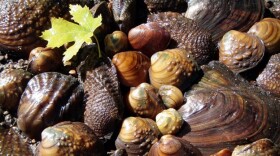In this month's installment of Field Notes, Trout Lake Station’s Gretchen Gerrish talks about how animals are impacted when winter lingers, and how winter severity is tracked
This month, I have been worried about our furry forest friends that have to post hole through waist deep snow on a daily basis to reach the very minimal remaining forage accessible above the snowline. As animals emerge from hibernation and torpor, begin reproducing, and increase their movements; the snow depth, melt water, and softening ice on lakes create numerous survival challenges.
By the end of last month, northern Wisconsin had already reached the ‘severe or ‘very severe’ annual winter index thresholds set by the Wisconsin DNR for the first time since 2013. The highest ‘weather severity index’ quantified in northern Wisconsin was measured in 2013 when heavy snowfall and below zero temperatures extended all the way into May. The ‘winter severity index’ was established in 1975 and is a formal calculation for quantifying winter conditions and predicting impacts on deer herds. Daily temperature and snow depth measurements are made at consistent locations throughout the state from December 1st – April 30th. The index scores one point for every day that reaches a minimum temperature less than zero and one point for each day with greater than 18 inches of snow. Based on winter deer mortality, fawn production, and buck harvest during the following year, the index defines thresholds for ‘mild, moderate, severe, and very severe’ conditions. ‘Severe’ and ‘very severe’ conditions were common prior to 1985, but only four severe winters have been recorded since. These occurred in 1995, 1996, 2000 and most recently in 2013. As of the end of March 2023, the northern most counties in Wisconsin had already reached the ‘very severe’ threshold for the first time since 2013.
Deep snow and cold temperatures through spring impact survival and reproduction for many species. Mobility, exposure, and access to food are the main stressors during this period. Deer, elk, and moose actively forage and move throughout the winter. When snow gets deep, these ungulates benefit from sticking to packed trails, roads, and open travel corridors. While trail use reduces the energy required compared to wading through deep snow, trails become over-foraged and road use can lead to increased vehicle encounters. This behavior is evident in the commonly observed herds of small deer that frequently meander down Main Street in Boulder Junction or browse at the Bearskin Trailhead in Minocqua during mud season!
Unfortunately, in deer, eighty to ninety percent of starvation victims during a severe winter are the previous spring’s fawns. Signs of starvation include a fuzzy face, trim rump, and narrow saddle. But, the only way to confirm starvation is to sample the bone marrow. In healthy deer, marrow looks creamy, and fat filled. When starved, the fat is absorbed leaving the marrow red and jelly-like. Young deer are also more susceptible to predation in years when the snow is deep. Large predators like wolves and bobcats have less small prey available and can target deer on trails. These predators have more distributed weight and can traverse snowy crusts more easily, allowing them to successfully capture small deer stuck struggling through deep snow.
Animals that sleep through the winter like bears, racoons, skunks, and opossum are also impacted by the deep snow conditions but mostly by the conditions they emerge into. If snow remains deep, they can struggle to find food as they emerge from their dream-like winter torpor. Bears can doze for up to 100 days without food, water or a bathroom break. Waking up hungry in deep snow, bears will also use packed pathways and search out food of any kind. This can lead to more human encounters, attacked bird feeders, or break ins! Bear sightings in the area have begun and will likely be on the increase as our outdoor temperatures rise.









